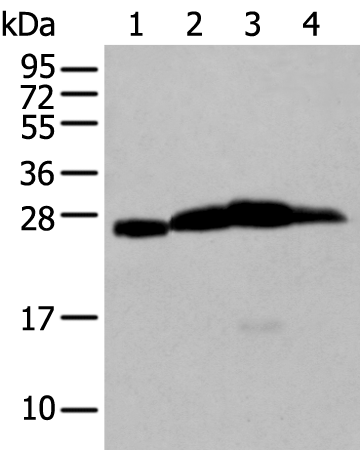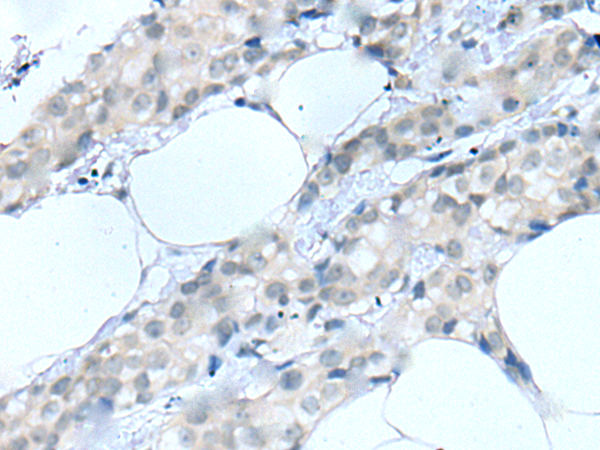

| WB | 咨询技术 | Human,Mouse,Rat |
| IF | 咨询技术 | Human,Mouse,Rat |
| IHC | 1/25-1/100 | Human,Mouse,Rat |
| ICC | 技术咨询 | Human,Mouse,Rat |
| FCM | 咨询技术 | Human,Mouse,Rat |
| Elisa | 1/2000-1/5000 | Human,Mouse,Rat |
| Aliases | BTN6; BTNL11; MOGIG2; NRCLP7 |
| WB Predicted band size | 28 kDa |
| Host/Isotype | Rabbit IgG |
| Antibody Type | Primary antibody |
| Storage | Store at 4°C short term. Aliquot and store at -20°C long term. Avoid freeze/thaw cycles. |
| Species Reactivity | Human, Mouse, Rat |
| Immunogen | Synthetic peptide of human MOG |
| Formulation | Purified antibody in PBS with 0.05% sodium azide and 50% glycerol. |
+ +
以下是3-4篇关于MOG抗体(髓鞘少突胶质细胞糖蛋白抗体)的经典文献及其摘要概括:
---
1. **文献名称**:*MOG-IgG in NMO and related disorders: a multicenter study of 50 patients. Part 1: Frequency, syndrome specificity, influence of disease activity, long-term course, association with AQP4-IgG, and origin*
**作者**:Jarius S, et al.
**摘要**:该研究通过回顾性多中心分析,探讨了MOG抗体在视神经脊髓炎谱系疾病(NMOSD)及其他脱髓鞘疾病中的频率和临床意义。研究发现,MOG抗体与AQP4抗体阳性的NMOSD存在不同的临床特征,且MOG抗体相关疾病对免疫治疗反应较好,复发率较低。
---
2. **文献名称**:*Clinical and MRI phenotype of children with MOG antibodies*
**作者**:Hacohen Y, et al.
**摘要**:该研究聚焦于儿童MOG抗体相关疾病,发现患儿常表现为急性播散性脑脊髓炎(ADEM)、视神经炎或横贯性脊髓炎。MRI显示广泛的皮质下白质病变,且多数患者对激素治疗敏感,但部分可能复发,提示需长期随访。
---
3. **文献名称**:*MOG antibody-associated encephalitis: A new autoimmune neurological disease*
**作者**:Reindl M, et al.
**摘要**:本文提出MOG抗体不仅与脱髓鞘疾病相关,还可导致脑炎症状(如癫痫、意识障碍),并强调其与多发性硬化(MS)和NMOSD的鉴别诊断重要性。研究通过病例分析,指出MOG抗体脑炎具有独特的免疫病理机制。
---
4. **文献名称**:*Diagnostic relevance of MOG antibodies in serum and CSF*
**作者**:Waters P, et al.
**摘要**:该研究比较了血清与脑脊液中MOG抗体的检测效能,发现血清检测已足够敏感,且高滴度MOG抗体与急性期疾病活动性相关。研究还验证了细胞基检测法(CBA)在诊断中的高特异性。
---
以上文献均发表于**Neurology**、**Lancet Neurology**等权威期刊,反映了MOG抗体疾病的临床多样性、诊断标志及治疗方向。如需具体年份或补充文献,可进一步说明!
Myelin oligodendrocyte glycoprotein (MOG) antibodies target MOG, a protein expressed on the surface of oligodendrocytes and myelin sheaths in the central nervous system (CNS). Initially studied in the context of experimental autoimmune encephalomyelitis (EAE), MOG was considered a potential autoantigen in multiple sclerosis (MS). However, research over the past decade has redefined MOG antibody-associated disease (MOGAD) as a distinct clinical entity, separate from MS and aquaporin-4 (AQP4) antibody-positive neuromyelitis optica spectrum disorder (NMOSD).
MOGAD predominantly presents with optic neuritis, transverse myelitis, or acute disseminated encephalomyelitis (ADEM)-like syndromes, often affecting both adults and children. Unlike AQP4 antibodies, MOG antibodies are predominantly IgG1 and appear to directly target conformational epitopes of the MOG protein. Diagnosis relies on cell-based assays (CBA) using full-length human MOG, as older ELISA methods lacked specificity.
Clinically, MOGAD often shows better recovery with steroids compared to NMOSD, though relapses occur in ~40% of cases. While initially considered monophasic, recurrent forms are increasingly recognized. Treatment typically involves immunosuppressants like corticosteroids, IVIG, or rituximab for relapsing cases. Ongoing research aims to clarify its pathophysiology, long-term outcomes, and optimal therapeutic strategies, highlighting its evolving significance in neuroinflammatory disorders.
×